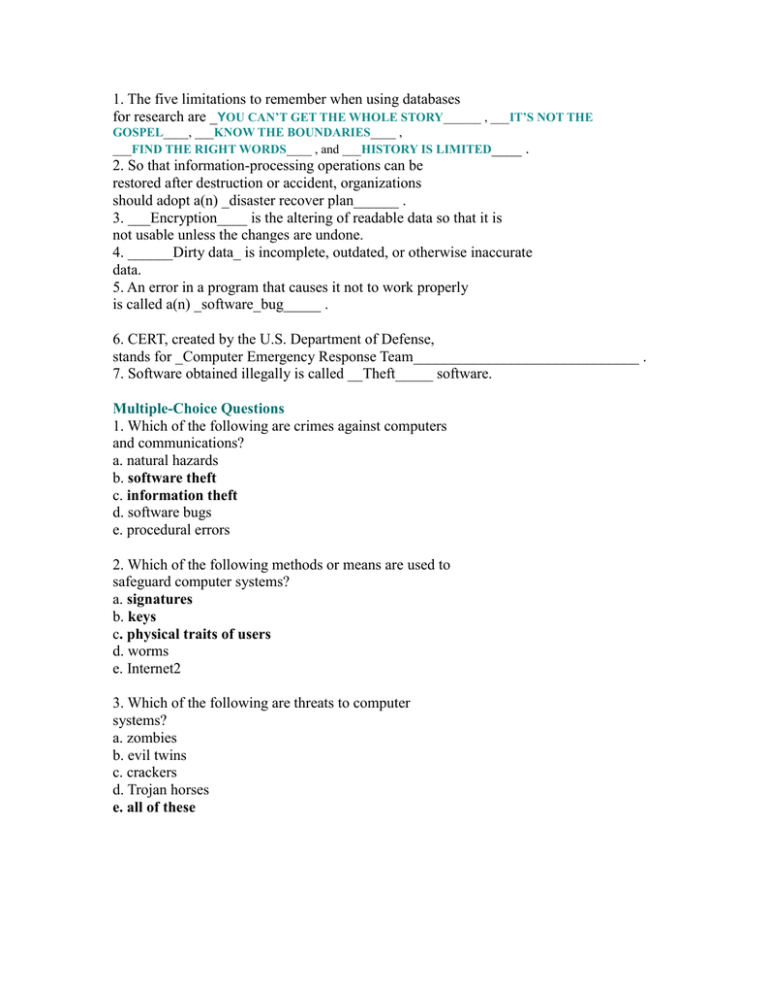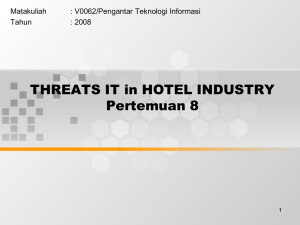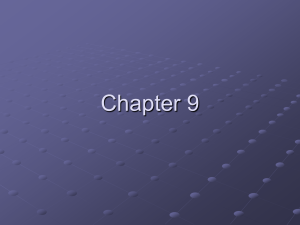1. The five limitations to remember when using databases ____ .
advertisement

1. The five limitations to remember when using databases for research are _YOU CAN’T GET THE WHOLE STORY______ , ___IT’S NOT THE GOSPEL____, ___KNOW THE BOUNDARIES____ , ___FIND THE RIGHT WORDS____ , and ___HISTORY IS LIMITED____ . 2. So that information-processing operations can be restored after destruction or accident, organizations should adopt a(n) _disaster recover plan______ . 3. ___Encryption____ is the altering of readable data so that it is not usable unless the changes are undone. 4. ______Dirty data_ is incomplete, outdated, or otherwise inaccurate data. 5. An error in a program that causes it not to work properly is called a(n) _software_bug_____ . 6. CERT, created by the U.S. Department of Defense, stands for _Computer Emergency Response Team______________________________ . 7. Software obtained illegally is called __Theft_____ software. Multiple-Choice Questions 1. Which of the following are crimes against computers and communications? a. natural hazards b. software theft c. information theft d. software bugs e. procedural errors 2. Which of the following methods or means are used to safeguard computer systems? a. signatures b. keys c. physical traits of users d. worms e. Internet2 3. Which of the following are threats to computer systems? a. zombies b. evil twins c. crackers d. Trojan horses e. all of these True/False Questions F 1. The category of computer crimes includes dirty data problems. F 2. Software bugs include procedural errors. T 3. Two types of encryption are public-key and private-key. F 4. It is impossible to detect when a photo has been morphed. T 5. If they got it from an employee’s credit report, employers must destroy any personal information about the employee before they throw it Short-Answer Questions 1. Give some examples of dirty data. Incomplete data ; inaccurate data; outdated data 2. Briefly describe how encryption works. is the process of altering readable data into unreadable form to prevent unauthorized access. Only who owns the key used to encrypt readable data can decrypt the unreadable data into a readable data. 3. What is a procedural error? Error due to the violation of some rules defined in a given procedure when performing or executing the procedure. For instance a given data entry procedure requires to use foot unit for distance measure and the data entry operator adopts meter unit. 4. Name five threats to computers and communications Systems. Hardware threat; software threat; Information threat; theft of time and services; internet related fraud; 5. The definition of computer crime distinguishes between two types. What are they? A computer crime can be of two types. (1) It can be an illegal act perpetrated against computers or telecommunications, or (2) it can be the use of computers or telecommunications to accomplish an illegal act. 6. What is phishing? sending emails that appear to come from a trusted source, which direct you to a website where you’re asked to reveal personal information. 7. If your employer is checking on you, what might he or she be watching for? Watching for a potential misuse of technology: playing games; shopping; writing personal emails... 8. What are three ways of verifying legitimate right of access to a computer system? Something you have; something you know; who you are 9. Name four environmental problems caused by Computers. Hazardous toxins involved in computer manufacture Wireless devices interfering in hospital activities and with medical devices Used computers/monitors contain toxic substances that must be disposed of properly Visual pollution is created by the forest of wireless towers, roof antennas, satellite dishes 10. What is the “digital divide Technology doesn’t produce widely shared economic gains but instead widens the gap between those who have the right skills and those who don’t. Technology may affect the gap between the rich and the poor between high and low income households, among different racial groups, between Northern and Southern states, and rural and urban households.

